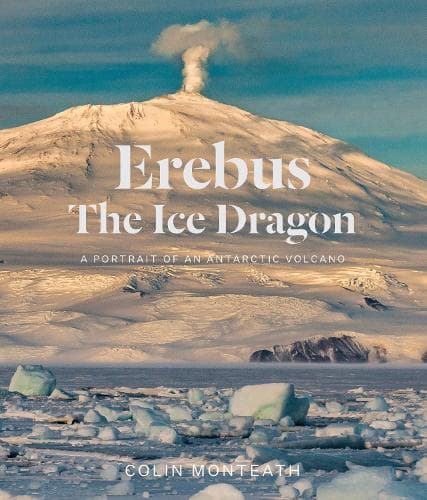Review: Erebus the Ice Dragon: a portrait of an Antarctic volcano
Reviewed by Alison Ballance
In Greek mythology, Erebus was son of Chaos, and god of darkness and shadows. Erebus was also the former warship, captained by James Clark Ross, whose crew was the first – in 1841 - to see the actively erupting Antarctic volcano which they named after their ship. Erebus the volcano dominates Ross Island, which is home to both New Zealand’s Scott Base and the United States’ McMurdo Station, and it is the centrepiece of a stunning new book from mountain and polar photographer Colin Monteath.
Monteath has had a long and productive association with Antarctica. He has spent 32 seasons there and has photographed it and written about it many times. His latest lavishly illustrated book, Erebus the Ice Dragon: a portrait of an Antarctic volcano, traverses history, adventure, science, geography and art, and is a fine addition to the library of Antarctic literature.
Monteath writes that, ‘Erebus is the molten heart of a mountainous island located at the juncture of saltwater ice and a vast continent buried by the thickest freshwater ice on the planet.’ It is a mountain that has clearly captured his imagination and in this he is not alone. With its distinctive summit plume of steam and cloud streaming from its summit at 3794-metres, Erebus looms over - and is also at the heart of - many of the great tales of Antarctic exploration.
It was first climbed in 1908 by members of the 1907-09 British Antarctic Expedition, led by Ernest Shackleton, which established a winter base at Cape Royds, at the base of the volcano. The geologists in the summit party peered into the red-hot crater, collected rock samples and marvelled at the misshapen 20-metre tall towers of ice that had formed above steaming fumaroles.
In 1912, members of the British Antarctic Terra Nova expedition, based at Cape Evans, made the second ascent, 11 months after expedition leader Robert Scott and companions perished on their return journey from the South Pole.
These ascents were not the main business of those expeditions but they are lovingly detailed in the book, as are more recent ascents starting from 1959, when New Zealand was establishing Scott Base and an Antarctic presence that has continued to the present-day.
Monteath begins the book with several chapters introducing Antarctica and its climatic history (‘carved by ice and forged in fire’), along with its volcanic geology (‘a continent ringed by fiery islands’). Historical chapters recount the peak’s discovery and early ascents, including sketches along with poetry and prose created by expedition members.
He pays tribute to geochemist Philip Kyle and his 50-year quest to understand the mountain, which is the southern-most active volcano in the world. Erebus has been active for 1.3 million years, with a very active lava lake that can fling out lava bombs up to 10-metres across and reaching temperatures inside of more than 800°C. It is part of a long chain of volcanoes, most extinct, that runs along the 3000-kilometre long West Antarctic Rift System. It is a natural laboratory that intrigues volcanologists and microbiologists, and there are later chapters in the book describing research efforts and findings.
Monteath has also gathered reflections from himself and others on the 1979 Ross Island air crash, in which an Air New Zealand sightseeing flight crashed with the loss of all 257 aboard. Although the name Erebus is inextricably linked with the disaster, he is at pains to correct the record, writing that the “aircraft did not hit Erebus” but rather “crashed at 447 metres altitude on a gentle snow slope at the base of Ross Island.”
The last chapter belongs to Antarctic art expert Adele Jackson, who lyrically guides us through some of the art and writings that put a spotlight on ‘Erebus the ice dragon.’ It is a fitting end to an ambitious book, written by a polar adventurer who knows this volcano inside out – after all, in 1978 he was the first person to abseil down into the Inner Crater of Erebus.
Reviewed by Alison Ballance
